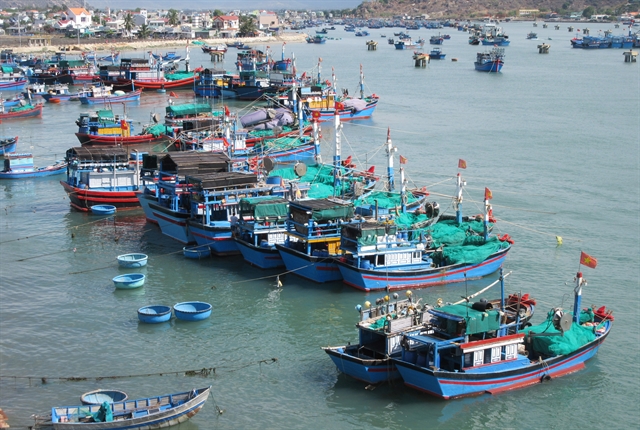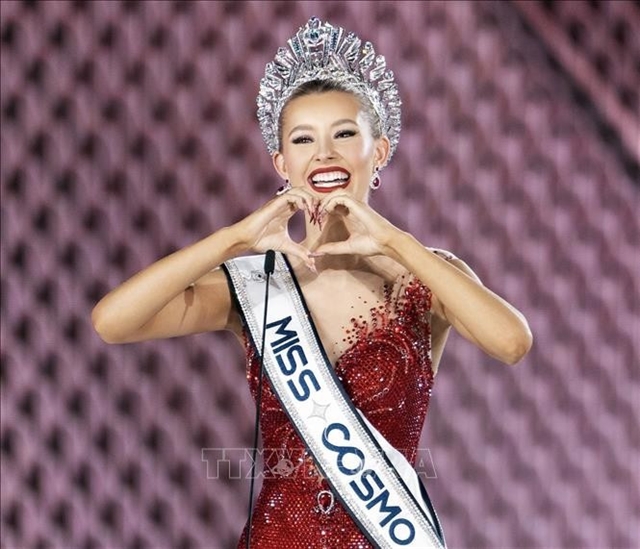 Environment
Environment

Việt Nam needs to carry out practical measures to manage and reduce marine plastic waste to ensure sustainable development of the fishery industry, according to experts at a workshop held in Hà Nội on Thursday.

|
| Fishing vessels in Ninh Hải District in central coastal province of Ninh Thuận. VNA/VNS Photo |
HÀ NỘI — Việt Nam needs to carry out practical measures to manage and reduce marine plastic waste to ensure sustainable development of the fishery industry, according to experts at a workshop held in Hà Nội yesterday.
“Given the resources depletion and impacts of climate change, it is important to develop the circular economy to ensure sustainable development,” said Nguyễn Thanh Tùng, head of Việt Nam’s Institute of Fisheries Economics and Planning.
He added that Việt Nam needs to manage and recycle plastic waste and that measures to tackle the plastic waste issues require the Government, local authorities, social and international organisations and stakeholders and individuals all working together.
The workshop was held by the Việt Nam’s Institute of Fisheries Economics and Planning and the UNDP Vietnam, aiming to share and exchange information on the current status of plastic waste in fishery industry and find solutions to reduce, collect and recycle plastic waste from fishing vessels.
Đào Xuân Lai, Head of Climate Change and Environment Unit of UNDP Vietnam said Việt Nam’s fishery industry is facing a number of issues, including resources depletion, competition among marine economic sectors, climate change.
“Marine waste is also a huge challenge, " Lai said.
"In Quy Nhơn port alone, there are about 10,000 boats and vessels, none of which bring back plastic waste for recycle. The amount of plastic dumped into the ocean is huge and this is a critical challenge.”
Plastic waste in fish farming is also a big issue in Việt Nam.
According to Vũ Thị Hồng Ngân from Việt Nam’s Institute of Fisheries Economics and Planning, the total amount of plastic used for intensive shrimp farming surveyed is 1,658-1,955 tonnes/ha/year. There were 110,000ha of allocated land for white-leg shrimp farming. About 91,000-107,000 tonnes of plastic per year were used from intensive white-leg shrimp farming and 90% of them was collected.
Meanwhile, plastic waste on fishing boats is mostly from fishing nets, post-harvest preservation and daily life, she said.
Everyday items found on boats include plastic bottles, plastic bags, packages of instant noodles, milk cartons and cooking oil bottles. They weigh about 4-6 kg per vessel every sea trip for vessels of seven to 10 people and 95 per cent of them are not collected, according to Ngân.
“There are several difficulties in the management and control of plastic waste in fisheries sector," Ngân added.
“Major challenges include weak policy mechanisms, limitation of farmer awareness, difference of culture between provinces and poor infrastructure.”
Other difficulties include small-scale fisheries production, poor inspection, examination and supervision, and the limitation of waste collecting and recycling technology, she added.
Ông Thị Cẩm Vân from the Dock Management Unit and Thọ Quang Fishing under Đà Nẵng's Department of Agriculture and Rural Development, said “It is important to raise awareness of boat owners and fishermen in collecting, classifying, not disposing of waste into the environment and leaving waste in the right places.
“They are aimed at reducing the use of single-use plastic stuff, plastic bags are difficult to decompose, contributing to reducing the amount of waste to be treated.”
It is important to take stronger and more decisive measures such as regulations on placing a trash bin on the boat in accordance with the conditions on fishing boats at the technical regulations for fishing vessels and at the same time assigning functional agencies (registration agencies) to inspect the implementation, she said.
Proposing a model to reduce plastic waste from fishing boats at Quy Nhơn Fishing Port, Hoàng Thị Diệu Linh a representative from UNDP Vietnam said it is necessary to survey, evaluate and inventory the plastic waste on fishing boats onboard.
There should be a collection centre with sorting and pressing system at the fishing port and pressing equipment on fishing ports, connecting to the collection system of the Material Recycling Facility (MRF), she said.
It is also important to develop a legal basis for regulations on bringing plastic waste back to the shore by the fishing boats, she added.
In 2020, Việt Nam’s total seafood output reached 8.4 million tonnes, of which the catch was 3.8 million tonnes and farming was nearly 4.6 million tonnes, according to the Directorate of Fisheries under the Ministry of Agriculture and Rural Development.
Việt Nam was the fourth major producer of fishery and aquaculture in the world with the seafood export turnover reaching US$8.5 billion a year.
According to the World Economic Forum, Việt Nam generates an estimated 3.7 million tonnes of plastic waste every year, only 10 to 15 per cent of which is eventually collected for recycling.
Around 730,000 tonnes of plastic waste leak from the country into the ocean every year. — VNS




